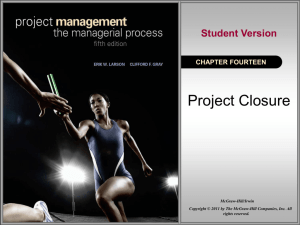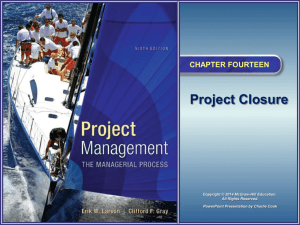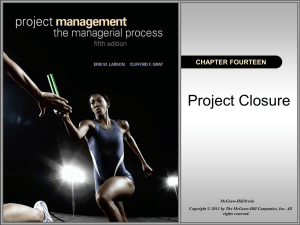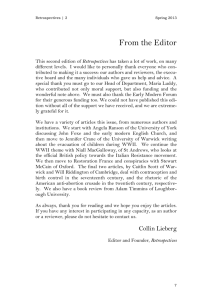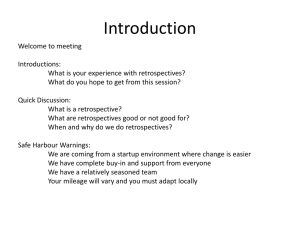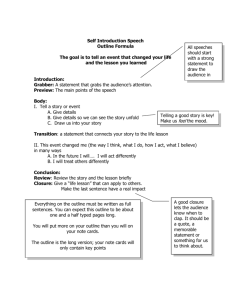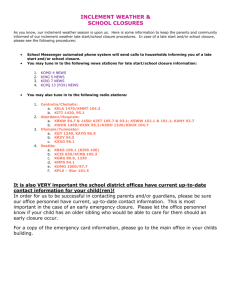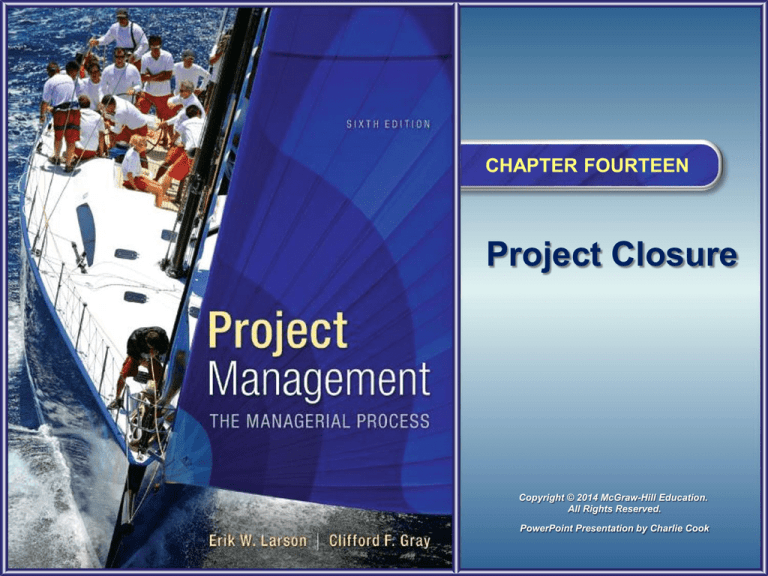
CHAPTER FOURTEEN
Project Closure
Copyright © 2014 McGraw-Hill Education.
All Rights Reserved.
PowerPoint Presentation by Charlie Cook
Where We Are Now
14–2
Project Closure
• Types of Project Closure
– Normal
– Premature
– Perpetual
– Failed Project
– Changed Priority
• Close-out Plan:
Questions to be Asked
– What tasks are required
to close the project?
– Who will be responsible
for these tasks?
– When will closure begin
and end?
– How will the project be
delivered?
14–3
Implementing Project Closedown
1. Getting delivery acceptance from the
customer.
2. Shutting down resources and releasing
them to new uses.
3. Evaluating the team, team members and
the project manager; and reassigning
project team members.
4. Closing accounts and paying all bills.
5. Delivering the project to the customer.
6. Creating a final report.
14–4
Creating the Final Report
• Executive Summary
– Project goals met/unmet
– Stakeholder satisfaction
with project
– User reactions to quality
of deliverables
• Review and Analysis
– Project mission and
objective
– Procedures and
systems used
– Organization resources
used
• Recommendations
– Technical improvements
– Corrective actions
• Lessons Learned
– Reminders
– Retrospectives
• Appendix
– Backup data
– Critical information
14–5
Pre-Implementation Conditions: Team
1. Are standards and goals for measuring performance clear,
challenging, and attainable? Lead to positive consequences?
2. Are responsibilities and performance standards known
by all team members?
3. Are team rewards adequate? Management believes teams are
important?
4. Is there a career path for successful project managers
5. Does the team have discretionary authority to manage
short-term difficulties?
6. Is there a high level of trust within the organization culture?
7. Are there criteria beyond time, cost, and specifications?
14–6
Project Performance Evaluation: Individual
• Performance Assessment Responsibilities:
– Functional organization or functional matrix: the
individual’s area manager.
• The area manager may solicit the project manager’s opinion
of the individual’s performance on a specific project.
– Balanced matrix: the project manager and the area
manager jointly evaluate an individual’s performance.
– Project matrix and project organizations: the project
manager is responsible for appraising individual
performance.
14–7
Conducting Performance Reviews
• Begin by asking the individual to evaluate his or her own
performance.
• Avoid drawing comparisons with other team members;
rather, assess the individual in terms of established
standards and expectations.
• Focus criticism on specific behaviors rather than on the
individual personally.
• Be consistent and fair in treatment of all team members.
• Treat the review as one point in an ongoing process.
14–8
Individual Performance Assessment
• Multiple rater appraisal (“360-degree
feedback)
– Involves soliciting feedback concerning team
members’ performance from all of the people
that their work affects.
• Project managers, area managers, peers,
subordinates, and customers.
14–9
Retrospectives
• Lessons Learned
– An analysis carried out during and shortly after the
project life cycle to capture positive and negative
project learning—“what worked and what didn’t?”
• Goals of Retrospectives
– To reuse learned solutions
– To stop repetitive mistakes
14–10
The Value of Retrospective Analyses
• Making Retrospectives Effective:
– Use an independent facilitator to guide the project
team through the analysis project activities.
– Include a minimum of three in-process learning gates
during the life project cycle.
– Designate a team member as owner for each point in
the retrospective.
– Develop an easy-to-use learning repository to ensure
future utilization of retrospective lessons.
– Mandate use of retrospectives as part of the normal
process for all projects.
14–11
Characteristics of a Closure Facilitator
1. No direct involvement or direct interest in the project.
2. Perceived as impartial and fair
3. Respect of senior management and other project
stakeholders.
4. Willingness to listen.
5. Independence and authority to report audit results
without fear of recriminations from special interests.
6. Perceived as having the best interests of the
organization in making decisions.
7. Broad-based experience in the organization or
industry.
14–12
Initiating the Retrospective Review
• Have automatic times or points when audits will
take place. Avoid surprises.
• Conduct audits carefully and with sensitivity.
• Audit staff must independent from the project.
• Audit reports need to be used and accessible.
• Audits support organizational culture.
• Project closures should be planned and orderly.
• Certain “core conditions” must be in place to support
team and individual evaluation.
• Conduct individual and team evaluations separate
from pay or merit reviews.
14–13
Archiving Retrospectives
• Classifying of Projects:
– Project type
– Size
– Staffing
– Technology level
– Strategic or support
– Issues and problems
– Project mission and objectives
– Procedures and systems used
– Organization resources used
14–14
Key Terms
Lessons learned
Performance review
Project closure
Project evaluation
Project facilitator
Retrospective
Team evaluation
360-degree review
14–15


